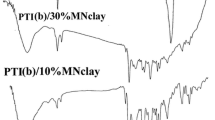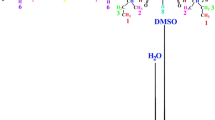Abstract
Synthesis and characterization of novel amine terminated polybutadiene, polyurea and TiO2-nanocomposites is the aim of current art work. In this regard, polyurea synthesized trough following consecutive reactions: 1. Oxidative chains scission of polybutadiene (PB) by meta-chloroperbenzoic acid (m-CPBA) and periodic acid (H5IO6) to prepare telechelic aldehyde functionalized polybutadiene, 2. Terminal amine functionalized polybutadiene synthesis via reductive amination reaction of prepared aldehyde functionalized polybutadiene and ethylenediamine (EDA) by sodium borohydride (NaBH4) and finally, 3. Telechelic polyurea preparation through the reaction of synthesized amine functionalized polybutadiene and toluene diisocyanate (TDI). A one-pot polymerization procedure was employed to synthesize nanocomposites by the incorporation of 1 to 3% of surface modified TiO2 nanoparticles by amino propyl triethoxy silane (APTS). Successful synthesize of amine functionalized polybutadiene, polyurea and nanocomposites investigated using 1H-NMR and FT-IR spectroscopy techniques. TGA/DTG and DSC methods proved successful surface modification of nanoparticles, improved thermal stabilities with lower degradation rates and superior thermal characteristics especially in 3 wt% nanocomposite when compared by pristine sample. SEM, XRD and AFM analysis confirmed successful nanocomposite synthesis with progressed morphologic and topographic properties.
Graphical abstract












Similar content being viewed by others
Abbreviations
- HTPB:
-
Hydroxy terminated polybutadiene
- CTPB:
-
Carboxy terminated polybutadiene
- EHTPB:
-
Epoxidized hydroxy terminated polybutadiene
- RHTPB:
-
Reduced hydroxy terminated polybutadiene
- PB:
-
Polybutadiene
- Ald:
-
Telechelic aldehyde functionalized polybutadiene
- Am:
-
Telechelic amine functionalized polybutadiene
- PUr:
-
Polyurea
- TiO2@APTS:
-
Aminopropyltriethoxysilane surface modified TiO2 nanoparticle
- PUr-TiO2 :
-
Nanocomposite of polyurea with TiO2@APTS core–shell organosilane filler
- PUr-1TiO2 and PUr-3TiO2 :
-
Nanocomposites with respectively 1 and 3 wt% TiO2@APTS nanoparticle in PUr matrix
- 1H-NMR:
-
Proton nuclear magnetic resonance spectroscopy
- FT-IR:
-
Fourier transform-infrared spectroscopy
- TGA/DTG:
-
Thermogravimetric and differential thermogravimetric analysis
- DSC:
-
Differential scanning calorimetry
- SEM:
-
Scanning electron microscopy
- XRD:
-
X-ray diffraction
- AFM:
-
Atomic force microscopy
References
Bai J, Li H, Shi Z, Yin J (2015) An eco-friendly scheme for the cross-linked polybutadiene elastomer via thiol-ene and diels-alder click chemistry. Macromolecules 48:3539–3546. https://doi.org/10.1021/acs.macromol.5b00389
Polgar LM, Van Duin M, Broekhuis A, Picchioni F (2015) Use of diels-alder chemistry for thermoreversible cross-linking of rubbers: The next step toward recycling of rubber products? Macromolecules 48:7096–7105. https://doi.org/10.1021/acs.macromol.5b01422
Fang Y, Zhan M, Wang Y (2001) The status of recycling of waste rubber. Mater Des 22:123–127. https://doi.org/10.1016/S0261-3069(00)00052-2
Trovatti E, Lacerda TM, Carvalho AJF, Gandini A (2015) Recycling tires? Reversible crosslinking of poly(butadiene). Adv Mater 27:1–4. https://doi.org/10.1002/adma.201405801
Nikje MMA, Hajifatheali H (2013) Performance of dimethyl dioxirane/nano-TiO2 on epoxidation of polybutadiene and hydroxyl terminated polybutadiene. J Elastomers Plast 45:457–469. https://doi.org/10.1177/F0095244312457800
Berto P, Grelier S, Peruch F (2017) Telechelic polybutadienes or polyisoprenes precursors for recyclable elastomeric networks. Macromolecules 38:2–7. https://doi.org/10.1002/marc.201700475
Berto P, Pointet A, Coz CL, Grelier S, Peruch F (2017) Recyclable telechelic cross linked polybutadiene based on reversible Diels–Alder chemistry. Macromolecules 51:651–659. https://doi.org/10.1021/acs.macromol.7b02220
Phinyocheep P, Phetphaisit CW, Derouet D, Campistron I, Brosse JC (2005) Chemical degradation of epoxidized natural rubber using periodic acid: preparation of epoxidized liquid natural rubber. J Appl Poly Sci 95:6–15. https://doi.org/10.1002/app.20812
Fainleib A, Pires RV, Lucas EF, Soares BG (2013) Degradation of non-vulcanized natural rubber—renewable resource for fine chemicals used in polymer synthesis. Polimeros 23:441–450. https://doi.org/10.4322/polimeros.2013.070
Morita A, Maughon BR, Bielawski CW, Grubbs RH (2000) A ring-opening metathesis polymerization (romp) approach to carboxyl- and amino-terminated telechelic poly(butadiene)s. Macromolecules 33:6621–6623. https://doi.org/10.1021/ma000013x
Quagliano J, Bocchio J, Ross P (2019) Mechanical and swelling properties of hydroxyl-terminated polybutadiene-based polyurethane elastomers. TMS 71:2097–2102. https://doi.org/10.1007/s11837-019-03417-8
Zhou Q, Jie S, Li BG (2015) Facile synthesis of novel HTPBs and EHTPBs with high cis-1,4 content and extremely low glass transition temperature. Polymer 67:208–215. https://doi.org/10.1016/j.polymer.2015.04.078
Gold BJ, Hovelmann CH, Weiss C, Radulescu A, Allgaier J, Pyckhout-Hintzen W, Wischnewski A, Richter D (2016) Sacrificial bonds enhance toughness of dual polybutadiene networks. Polymer 87:123–128. https://doi.org/10.1016/j.polymer.2016.01.077
Zhang Q, Shu Y, Liu N, Lu X, Shu Y, Wang X, Mo H, Xu M (2019) Hydroxyl terminated polybutadiene: chemical modification and application of these modifiers in propellants and explosives. Cent Eur J Energetic Mater 16:153–193. https://doi.org/10.22211/cejem/109806
Tripathi M, Parthasarathy S, Roy PK (2020) Mechanically robust polyurea nanofibers processed through electrospinning technique. Mater Today Commun 22:100771. https://doi.org/10.1016/j.mtcomm.2019.100771
Bonattini VH, Paula LA, Jesus NA, Tavares DC, Nicolella HD, Magalhaes LG, Molina EF (2020) One-step formation of polyurea gel as a multifunctional approach for biological and environmental applications. Polym In 69:476–484. https://doi.org/10.1002/pi.5978
Liu W, Fang C, Chen F, Qiu X (2020) Strong, reusable and self-healing lignin-containing polyurea adhesives. Chemsuschem 17:1–11. https://doi.org/10.1002/cssc.202001602
Iqbal N, Tripathi M, Parthasarathy S, Kumar D, Roy PK (2016) Polyurea coatings for enhanced blast-mitigation: a review. RSC 6:10706–109717. https://doi.org/10.1039/c6ra23866a
Wu C, Wang J, Chang P, Cheng H, Yu Y, Wu Z, Dong D, Zhao F (2012) Polyureas from diamines and carbon dioxide: synthesis, structures and properties. Phys Chem Chem Phys 14:464–468. https://doi.org/10.1039/C1CP23332G
Holzworth K, Jia Z, Amirkhizi AV, Qiao J, Nemat-Nasser S (2013) Effect of isocyanate content on thermal and mechanic al properties of polyurea. Polymer 54:3079–3085. https://doi.org/10.1016/j.polymer.2013.03.067
Tian X, Zhang S, Ma Y-Q, Luo Y-L, Xu F, Chen Y-S (2019) Preparation and vapor-sensitive properties of hydroxyl-terminated polybutadiene polyurethane conductive polymer nanocomposites based on polyaniline-coated multiwalled carbon nanotubes. Nanotechnology 31:195504. https://doi.org/10.1088/1361-6528/ab704c
Vijayan PP, Puglia D, Vijayan PP, Kenny JM, Thomas S (2017) The role of clay modifier on cure characteristics and properties of epoxy/clay/carboxyl-terminated poly(butadiene-co-acrylonitrile) (CTBN) hybrid. Mater Technol 32:171–177. https://doi.org/10.1080/10667857.2016.1161946
Lade R, Wasewar K, Sangtyani R, Kumar A, Shende D, Peshwe D (2019) Influence of the addition of aluminium nanoparticles on thermo-rheological properties of hydroxyl terminated polybutadiene-based composite propellant and empirical modelling. J Therm Anal Calorim 138:211–223. https://doi.org/10.1007/s10973-019-08149-0
Dalod APM, Henriksen L, Grande T, Einarsrud MA (2017) Functionalized TiO2 nanoparticles by single-step hydrothermal synthesis: the role of the silane coupling agents. Nanotechnology 8:304–312. https://doi.org/10.3762/bjnano.8.33
Hussein MA, Alamry KA, Almehmadi SJ, Elfaky MA, Cancar HD, Asiri AM, Hussien MA (2020) Novel biologically active polyurea derivatives and its TiO2-doped nanocomposites. Des Monomers Polym 23:59–74. https://doi.org/10.1080/15685551.2020.1767490
Rahmatpanah Z, Nikje MMA (2020) A novel synthesis of polybutadiene-based polyurethane binder and conductive graphene–polyurethane nanocomposites: a new approach to polybutadiene recycling. Polym Bull. https://doi.org/10.1007/s00289-020-03288-z
Nikje MMA, Hajifatheali H (2012) Synthesis and characterization of terminally functionalized and epoxidized hydroxyl-terminated polybutadiene. Polym Bull 68:973–982. https://doi.org/10.1007/s00289-011-0592-y
Bahadur A, Saeed A, Iqbal S, Shoaib M, Rahman MS, Bashir MI, Asghar M, Ali MAM (2017) Biocompatible waterborne polyurethane-urea elastomer as intelligent anticancer drug release matrix: a sustained drug release study. React Funct Polym 119:57–63. https://doi.org/10.1016/j.reactfunctpolym.2017.08.001
Sever E, Unal HI (2015) Colloidal properties of surface functionalized nanocube-TiO2/poly(3-octylthiophene) core/shell conducting nanocomposite. Appl Surf Sci 355:1028–1036. https://doi.org/10.1016/j.apsusc.2015.07.013
Yang Y, Zhou Y, Wang T (2014) Preparation of optically active polyurethane/TiO2/MnO2 multilayered nanorods for low infrared emissivity. Mater Lett 133:269–273. https://doi.org/10.1016/j.matlet.2014.06.184
Zhou Q, Jie S, Li B-G (2014) Preparation of hydroxyl-terminated polybutadiene with high Cis-1,4 content. Ind Eng Chem Res 53:17884–17893. https://doi.org/10.1021/ie503652g
Koberstein JT (1986) Simultaneous SAXS-DSC study of multiple endothermic behavior in polyether-based polyurethane block copolymers. Macromolecules 19:714–720. https://doi.org/10.1021/ma00157a039
Chen TK, Chui JY, Shieh TS (1997) Glass transition behaviors of a polyurethane hard segment based on 4,4¢-diisocyanatodiphenylmethane and 1,4-butanediol and the calculation of microdomain composition. Macromolecules 30:5068–5074. https://doi.org/10.1021/ma9618639
Balko J, Fernández-d’Arlas B, Pöselt E, Dabbous R, Müller AJ, Thurn-Albrecht T (2017) Clarifying the origin of multiple melting of segmented thermoplastic polyurethanes by fast scanning calorimetry. Macromolecules 50:7672–7680. https://doi.org/10.1021/acs.macromol.7b00871
Leung LM, Koberstein JT (1986) DSC annealing study of microphase separation and multiple endothermic behavior in polyether-based polyurethane block copolymers. Macromolecules 19:706–713. https://doi.org/10.1021/ma00157a038
Cai Y, Jiang J-S, Zheng B, Xie M-R (2012) Synthesis and properties of magnetic sensitive shape memory Fe3O4/poly(e-caprolactone)-polyurethane nanocomposites. Appl Polym Sci 127:1–8. https://doi.org/10.1002/app.36849
Ross P, Escobar G, Sevilla G, Quagliano J (2017) Micro and nanocomposites of polybutadienebased polyurethane liners with mineral fillers and nanoclay: thermal and mechanical properties. Open Chem 15:46–52. https://doi.org/10.1515/chem-2017-0006
Gómez-Fernández S, Ugarte L, Peña-Rodriguez C, Zubitur M, Corcuera MA, Eceiza A (2016) Flexible polyurethane foam nanocomposites with modified layered double hydroxides. J Appl Clay Sci 123:109–120. https://doi.org/10.1016/j.clay.2016.01.015
Kebir N, Campistron I, Laguerrea A, Pilard JF, Bunel C, Jouenne T (2007) Use of telechelic cis-1,4-polyisoprene cationomers in the synthesis of antibacterial ionic polyurethanes and copolyurethanes bearing ammonium groups. Biomaterials 28:4200–4208. https://doi.org/10.1016/j.biomaterials.2007.06.006
Cao R, Liu H, Pei D, Miao J, Zhang X (2017) Fabrication and properties of graphene oxide-grafted-poly(hexadecylacrylate) as a solid-solid phase change material. Compos Sci Technol 149:262–268. https://doi.org/10.1016/j.compscitech.2017.06.019
Lee HT, Lin LH (2006) Waterborne polyurethane/clay nanocomposites: novel effects of the clay and its interlayer ions on the morphology and physical and electrical properties. Macromolecules 39:6133–6141. https://doi.org/10.1021/ma060621y
Acknowledgements
The authors would like to thank Imam Khomeini International University (IKIU).
Funding
This research did not receive any specific grant from funding agencies in the public, commercial, or not-for-profit sectors.
Author information
Authors and Affiliations
Contributions
Both authors contributed to the study conception and design. Material preparation, data collection and analysis were performed by ZR. The first draft of the manuscript was written by ZR and MMAN commented on previous versions of the manuscript. Both authors read and approved the final manuscript.
Corresponding author
Additional information
Publisher's Note
Springer Nature remains neutral with regard to jurisdictional claims in published maps and institutional affiliations.
Supplementary Information
Below is the link to the electronic supplementary material.
Rights and permissions
About this article
Cite this article
Rahmatpanah, Z., Alavi Nikje, M.M. Synthesis and characterization of thermally stable polyurea-TiO2 nanocomposites based on amine terminated polybutadiene. Polym. Bull. 80, 2437–2455 (2023). https://doi.org/10.1007/s00289-022-04132-2
Received:
Revised:
Accepted:
Published:
Issue Date:
DOI: https://doi.org/10.1007/s00289-022-04132-2




